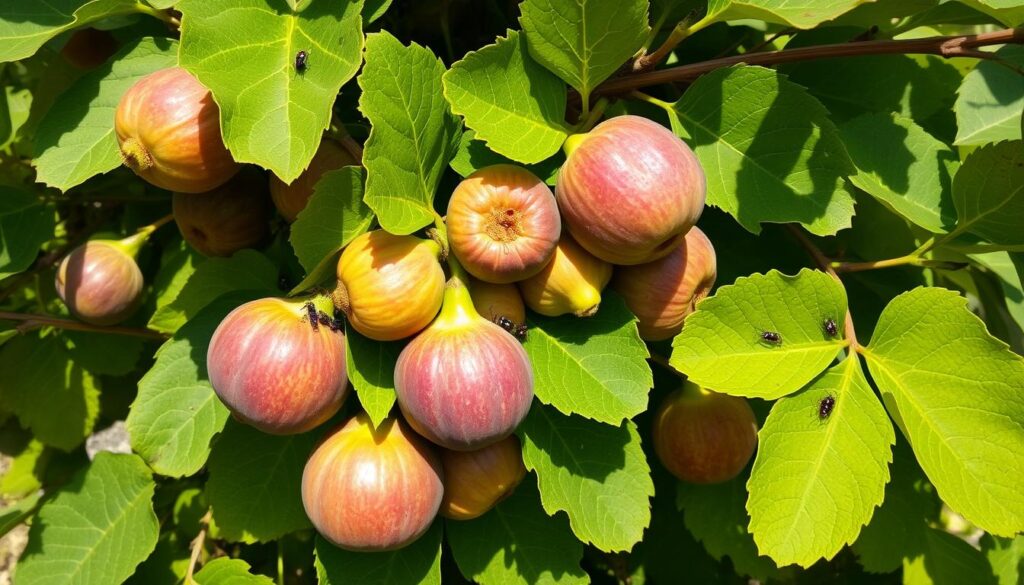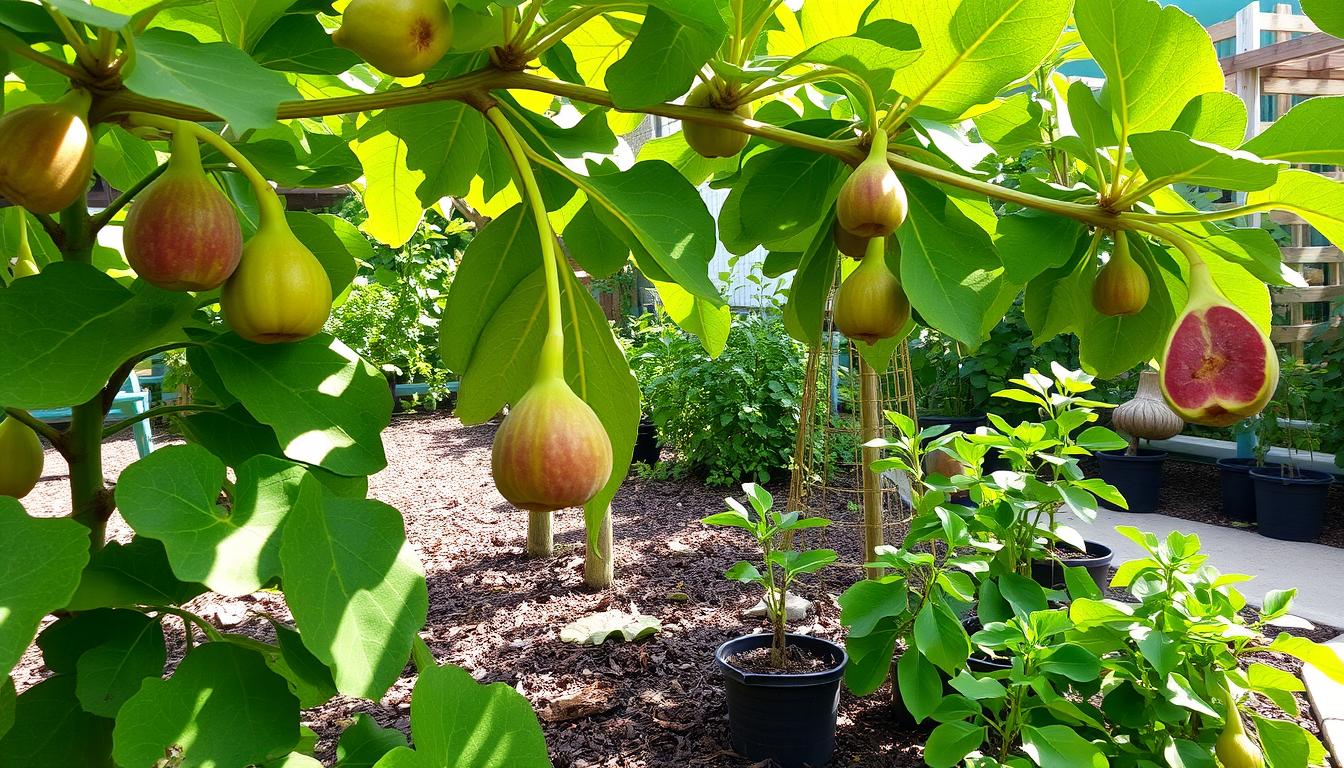Welcome to my guide on Home Fig Cultivation! If you want to learn how to grow figs at home, you’re in the right spot. Fig trees are easy to grow and offer a rewarding gardening experience. This guide is for beginners, giving you simple tips for growing fig trees.
With the right techniques and patience, you’ll soon enjoy sweet, delicious figs from your garden.
In this article, we’ll cover everything from understanding fig trees to practical care tips. I invite you to explore more about gardening and connect with a supportive community at Garden Beginner. Let’s start this fruitful journey together!
Key Takeaways
- Fig trees are easy to grow and provide rewarding fruit.
- Best grown in loamy, well-draining soil with good sunlight.
- Regular watering and feeding enhance fig production.
- Pruning helps maintain healthy growth and maximize yields.
- Figs require protection from frost during winter.
Understanding Fig Trees
Fig trees are a great choice for home gardeners who love fresh fruit. Knowing the different Types of Fig Trees helps pick the right one for your garden. Let’s explore the varieties and the joys of growing Figs at Home.
Types of Fig Trees for Home Cultivation
Many fig tree varieties do well in home gardens. Each has its own special traits. Here are some popular ones:
- Brown Turkey: Suitable for zones 5-9, this tree grows 10-25 feet tall and wide.
- Chicago Hardy: Recommended for zones 6-9, achieving heights of 10-15 feet and widths of 10-12 feet.
- Violette de Bordeaux: Thriving in zones 6-10, this compact tree matures to around 6-10 feet tall and 10 feet wide.
- Celeste: Best suited for zones 7-10, known for its sweetness and high yield.
- Black Mission: Ideal for zones 7-10, this large tree can grow up to 40 feet tall and 50 feet wide.
- Kadota: Perfect for zones 7-9, reaching heights of 8-15 feet.
Knowing these varieties helps choose the right fig tree for your garden. It ensures a successful fig-growing experience.
Benefits of Growing Figs at Home
Growing figs has many benefits for gardeners of all levels:
- Freshness: Homegrown figs taste better and are of higher quality, enjoyed right off the tree.
- Nutritional Value: Figs are full of vitamins, minerals, and antioxidants, supporting a healthy diet.
- Low Maintenance: These trees need little care, making them perfect for beginners.
- Adaptability: Fig trees grow well in many climates and conditions, showing hardiness and resilience.
- Aesthetic Appeal: Their beautiful foliage and unique fruit add beauty to any garden.
Fig trees grow in USDA hardiness zones 5-11, making them versatile for many places. By planting them in well-drained, loamy soil and ensuring they get enough sunlight, anyone can enjoy the benefits of growing figs at home.
How to Grow Figs at Home: A Beginner’s Guide
Starting a fig garden is exciting for plant lovers. To grow figs at home, you need to plan carefully. Choosing the right varieties is key, as they vary by climate. Brown Turkey, Chicago Hardy, and Celeste are good choices for their taste and hardiness.
I started by getting seedlings from local nurseries. I picked ones that fit my climate. It’s also important to know what fig trees need. They like well-draining soil and full sun for lots of fruit. Make sure to space them 10-15 feet apart for best growth.
Proper care is vital for growing figs at home. Water them deeply once a week, especially when it’s hot. Use a balanced fertilizer for strong growth. Fig trees can start producing fruit in 3-5 years, but some may start sooner.
Planting fig trees requires careful attention. For more on planting and soil, check out this link. It offers tips on growth and early care for fig trees.
Fig trees can be a great addition to your garden. With the right care, growing figs at home is very rewarding.
Choosing the Right Location
Choosing the right Fig Tree Location is key for growing figs well. Fig trees do best when they’re in the right spot. They need the right amount of sunlight, temperature, and climate to grow strong.
Optimal Sunlight Requirements
Fig trees need at least *six to eight hours* of direct sunlight every day. Placing them near south or east-facing walls helps them get more warmth and light. This is crucial for their growth and fruit production.
Without enough sunlight, fig trees can’t grow well. This affects the quality of their fruit.
Temperature and Climate Considerations
Fig trees love warm and subtropical places. They can handle cold down to about *15°F*, but they need extra care in very cold areas. It’s important to know your local climate to pick the right fig variety.
Keep an eye on the temperature to help your fig trees grow well. This is especially important during cold seasons.

| Environmental Factor | Requirement |
|---|---|
| Sunlight | 6-8 hours of direct sunlight daily |
| Temperature Tolerance | Down to 15°F |
| Soil pH | 5.5-6.5 (slightly acidic) |
| Drainage | Well-drained, organically rich soil |
Fig Tree Planting Guide
Starting your own fig tree garden is exciting. It’s important to know how to prepare and plant correctly. This guide will help you grow a beautiful garden.
Preparing the Soil for Fig Trees
Soil preparation is key for fig tree success. They love well-draining loamy soil with a pH of 6.0 to 6.5. This lets them absorb nutrients well.
I suggest adding compost to the soil for extra fertility. Before planting, dig a hole a foot wider than the root ball. Leave 4-6 inches of space around it. This helps the roots grow strong.
Planting Techniques for Success
Using the right planting techniques is crucial for your fig trees’ growth. Make sure the hole is deep enough for the roots without bending them. If using pots, choose ones that don’t restrict the roots too much.
Plant your tree at the same depth as it was in the nursery. This reduces transplant shock and helps your tree stay healthy. Fig trees need about eight hours of sunlight a day for the best results.
If you want to learn more, check out this resource on growing fig trees at home.
Fig Tree Care Essentials
Fig tree care is key for healthy growth and lots of fruit. It’s all about the right watering and fertilizing. Trees need enough water and food to grow strong and produce sweet figs.
Watering Techniques for Healthy Growth
Watering is vital for fig trees. New plants need water often to grow roots. Water them once a week when it’s dry.
Older trees can handle dry spells better. They only need water when it’s really dry. Check the soil moisture to know when to water. If the top soil is dry, it’s time.
But, don’t overwater. Fig trees like well-drained soil.
Fertilization and Nutrition Needs
Fertilizing is also important. Use a balanced organic fertilizer every 4-6 weeks when the tree is growing. This boosts fruit and tree health.
Tomato food is great too because it has lots of potassium. This helps figs grow. Mulching keeps the soil moist and adds nutrients.
| Watering Techniques | Fertilization Practices |
|---|---|
| Water once a week for new plants. | Use balanced organic fertilizer. |
| Allow established trees to dry out between waterings. | Apply every 4-6 weeks during growing season. |
| Avoid waterlogging to prevent root rot. | Consider tomato food for additional potassium. |
| Check soil moisture regularly. | Mulch to retain moisture and add nutrients. |
Managing Pests and Diseases
Growing fig trees at home can be rewarding but comes with challenges. You need to manage pests and diseases to keep your trees healthy. Knowing the common pests and diseases and how to prevent them will make gardening better.
Common Pests and How to Combat Them
Fig trees attract pests that can harm their growth. Here are Common Fig Pests I’ve seen:
- Fig Beetles: These pests damage leaves and fruit. Watch your trees and remove beetles or traps as needed.
- Aphids: Aphids suck sap, weakening trees. Check for them often and use natural predators like ladybugs.
- Spider Mites: Spider mites love dry conditions. Keep your trees watered to reduce their damage.
Using organic pest control like neem oil or insecticidal soap is safe for beneficial insects. For more tips, check out fig tree care resources.
Recognizing and Treating Diseases
Fig trees also face diseases that can slow their growth. Here are Fig Diseases to watch out for:
- Root Rot: Caused by too much water, avoid overwatering to prevent this disease.
- Leaf Spot: A fungal disease that looks like dark spots on leaves. Good air circulation and pruning can help.
Regularly check leaves and soil to catch diseases early. Early detection means you can act fast to protect your trees.

Fig Tree Pruning Tips
Pruning is key to keeping fig trees healthy and looking good. Knowing the right pruning techniques is important. It helps with better airflow and sunlight, which are good for the tree’s growth.
When and How to Prune Fig Trees
Pruning at the right time and in the right way is crucial. I prune in winter and early summer. This keeps the trees easy to manage and boosts fruit production.
It’s important to know the type of fig tree you have. Some trees produce one crop, while others produce two. Pruning for potted versus in-ground plants is different. Always remove crossing branches and encourage air flow.
- Create a permanent framework by assessing the desired shape: bush, tree, step-over, or fan.
- Use thinning cuts to maintain structure while avoiding excessive branching. This helps establish a strong foundation.
- Apply heading cuts when necessary to encourage new growth shaped towards light sources.
- Avoid shearing plants like hedges; instead, branch spacing should be adequate to allow light and air in.
Benefits of Regular Pruning
Regular pruning has many benefits, especially for fruit production. A two-stage approach keeps the tree healthy. This method increases fruit yields and keeps the tree strong.
Some key benefits of pruning include:
- Encouraging fruit production: Healthy branches mean more fruit.
- Improving air circulation: This reduces disease risk.
- Enhancing shape: It keeps the tree looking good in your garden.
Pruning tips are vital for a fig tree’s success. By using the right techniques and understanding the benefits, my fig trees do well for years.
| Variety | Zones | Height | Width |
|---|---|---|---|
| Brown Turkey Fig | 5-9 | 10-25 ft | 10-25 ft |
| Chicago Hardy Fig | 6-9 | 10-15 ft | 10-12 ft |
| Violette de Bordeaux Fig | 6-10 | 6-10 ft | 10 ft |
| Celeste Fig | 7-10 | Small size | N/A |
| Black Mission Fig | 7-10 | Up to 40 ft | Up to 50 ft |
| Kadota Fig | 7-9 | 8-15 ft | N/A |
Harvesting Figs
Harvesting figs is key for fig tree growers. Knowing when to pick them is crucial for quality. A ripe fig’s skin turns soft and slightly wrinkled. It should yield gently to pressure.
Waiting for this stage is important for the best taste. It ensures the fruit is at its peak flavor.
Determining the Right Time to Harvest
Fig picking timing is vital for a good harvest. The fruiting season varies by type. Most figs are ready in late summer.
Breba figs, for example, ripen in late spring to early summer. Look for these signs:
- Softness of the fruit indicating ripeness
- Color change that matches the variety’s typical coloration
- Slightly wrinkled skin, showing readiness for harvesting
Best Practices for Picking Figs
Gentle handling is crucial when picking figs. Here are some tips:
- Use scissors or pruners for a clean cut to prevent damaging the tree
- Harvest in the morning when temperatures are cooler to maintain fruit quality
- Avoid picking figs too early; premature fruit can lack sweetness
- Store harvested figs in a cool, dry place to prolong shelf life
Protecting the fruit ensures you enjoy it longer. Whether fresh or preserved, care during picking is key. For more tips, check this important resource.
Fig Tree Maintenance Throughout the Seasons
Keeping your fig tree healthy is key. Each season brings its own needs for your fig tree. In warmer months, watch the water closely. Give them deep water once a week to help them grow strong roots.
Also, using a balanced organic fertilizer can really help. It boosts growth and makes your tree more productive.
Seasonal Care for Fig Trees
Seasonal care means changing how you care for your tree based on the weather. In spring, I prune to help it grow and get ready for fruit. Summer is all about watching for pests and making sure they get enough water.
As fall comes, I start to get my trees ready for winter. I water less and focus on keeping them healthy. Sticking to a routine is important for keeping your tree happy and healthy.
Winter Protection Strategies
Winter can be tough on fig trees, especially when it gets really cold. To protect them, I cover pots with insulation or move them inside. If your tree is in the ground, mulch around it to keep it warm.
Wrapping the tree in burlap can also help shield it from the cold. Good winter care helps your tree bounce back strong in the spring.



Leave a Reply